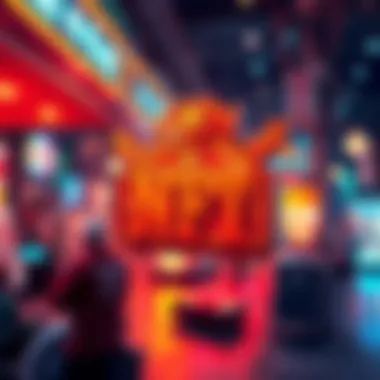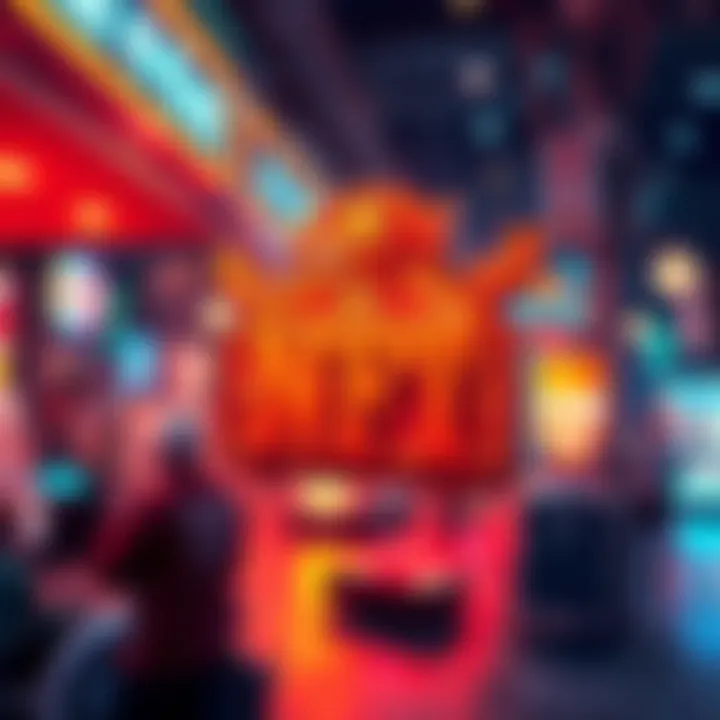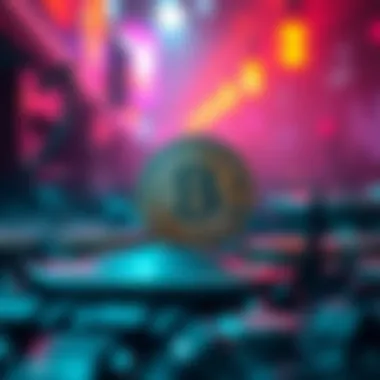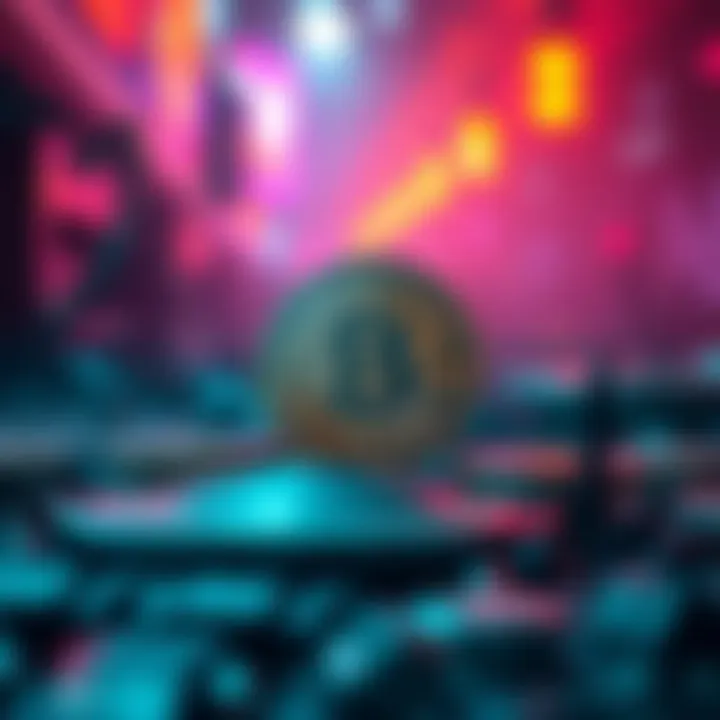Where to Buy NFTs: Your Complete Buying Guide


Intro
The digital world is buzzing with talk of Non-Fungible Tokens (NFTs), yet many still grapple with understanding how to navigate the buying process. In this guide, we'll cover the landscape of NFT purchases, dissecting popular platforms and payment methods while highlighting what you need to consider for a smooth transaction. With the rise of NFTs, it is pivotal to familiarize oneself with the trends shaping this space and the essentials of ownership and authenticity.
In particular, we’ll explore the varying marketplace options, from marketplaces like OpenSea and Rarible to emerging platforms that cater to niche interests. In addition, we’ll touch on the financial aspects involved in purchasing NFTs, including understanding crypto wallets and transaction fees. This comprehensive dive aims to serve not only newcomers but seasoned collectors as well, empowering them with insights to make informed decisions in the vibrant NFT ecosystem.
Crypto Insights
Understanding the intricacies of the NFT market requires a keen eye on trends and price movements. Being in the loop on these aspects can significantly enhance your purchasing experience.
Understanding Market Trends
The NFT landscape is constantly shifting, reflecting broader trends in both the art world and cryptocurrency markets. Popularity often surges around specific events or major movements in the digital art space. Keeping an ear to the ground means following influencers and participating in communities on platforms like Reddit and Discord. People speak of trends there, sometimes in jargon that's baffling at first, but it’s worth the effort to grasp their significance. Just think of social media as the pulse of the market, revealing what’s hot and what’s not.
Analyzing Price Fluctuations
Prices can swing like a pendulum based on various factors—artist reputation, uniqueness of the token, and even market speculation. Buyers might be tempted to chase trends, but it’s beneficial to have an eye on historical data. Websites like NonFungible.com provide tracking tools that can give insights into an NFT's average sale price over time.
"The key to success in NFTs is not only understanding the art but also understanding the market it is part of."
Frameworks to consider include market caps and trading volumes. Be wary of hype-driven purchases; not every token will appreciate over time. It’s much like buying art or collectibles— what’s valuable depends largely on perception and demand.
Educational Resources
A well-informed buyer navigates the NFT scene with more confidence. Educational resources are abundant, catering to various levels of expertise, from curious beginners to the technologically savvy.
Beginner's Guides to Cryptocurrency
Before you even think about entering the NFT market, it's crucial to understand cryptocurrencies—the backbone of most NFTs. Websites like Coinbase and Binance offer beginner-friendly resources for grasping the essentials of digital currency.
Advanced Blockchain Concepts
For those who already have a handle on the basics, diving into more complex concepts like smart contracts is vital. Ethereum, for example, hosts many NFTs, and knowing how these smart contracts function can provide clarity on ownership and rights. Resources like the Ethereum Foundation's website provide deeper understanding and guides for developers and investors looking to get their feet wet.
By harnessing the insights and resources described, you can approach the NFT marketplace with a much clearer perspective, ready to make decisions grounded in knowledge and awareness.
Understanding NFTs
Non-Fungible Tokens, or NFTs, have stirred up conversations across various strata of society, from tech-savvy individuals to art collectors. Before you can dive into the nitty-gritty of where to buy these digital assets, it’s essential to grasp what NFTs are and why they matter. This section aims to lay the groundwork by examining the fundamental concepts of NFTs, the technology that powers them, and their key characteristics.
Defining Non-Fungible Tokens
When we talk about tokens in the digital realm, they typically fall into two categories: fungible and non-fungible. Just think of currency—each dollar bill is interchangeable with another, meaning that they hold equal value. This fungibility is what makes currencies practical for transactions. Now, enter Non-Fungible Tokens. Unlike dollars or cryptocurrencies, each NFT is unique and cannot be swapped on a one-to-one basis.
NFTs can represent ownership of a variety of assets, like digital art, music, virtual real estate, or even tweets. They are usually built on blockchain technology, primarily Ethereum, which ensures their authenticity through decentralized verification. So, when you own an NFT, you're not just owning a piece of digital art; you own a unique token that signifies ownership, complete with its history of transactions.
The Technology Behind NFTs
At the heart of NFTs lies blockchain technology, a digital ledger that records all transactions in a decentralized manner. This decentralization ensures that no single entity can manipulate the records, adding a layer of security and trust. Each NFT is encoded with specific metadata, which includes details like the creator, ownership history, and any attached royalties.
Here's how it generally works:
- Smart Contracts: These are self-executing contracts with the terms directly written into code. They facilitate, verify, and enforce the negotiation and performance of agreements. In the case of NFTs, smart contracts handle the ownership transfer whenever a purchase occurs.
- Minting: This is the process of creating an NFT. When an artist mints their artwork as an NFT, they upload it to a blockchain, turning it into a unique digital artifact.
- Interoperability: Because NFTs are built on standardized protocols, they can be traded across different marketplaces. Whether you bought it on OpenSea or Rarible, your digital artwork remains easily transferable.
Key Characteristics of NFTs
Understanding the defining characteristics of NFTs can provide deeper insights into their appeal and why they represent a significant shift in how we perceive ownership in the digital age. Here are some of their crucial traits:
- Uniqueness: Each NFT is distinct. Two NFTs can be entirely different even if they represent the same type of asset.
- Scarcity: Creators can set a limited number of NFTs for a piece of art, creating a sense of scarcity, which can enhance its value.
- Indivisibility: Unlike cryptocurrencies that can be divided, NFTs cannot be split into smaller units. You either own the whole token or none of it.
- Provenance: The blockchain keeps an unalterable record of ownership, providing verifiable proof that can add to the asset's value over time.


"NFTs represent not just ownership; they show the pathway to a new world where creativity meets technology."
In summation, NFTs have transcended beyond mere digital artifacts. They are evolving into a cultural phenomenon that reshapes the way we authenticate and value digital ownership. Understanding these foundational principles is indispensable before venturing into the complexities of purchasing NFTs. Once these concepts are clear, one can confidently explore the various marketplaces and platforms available.
Popular NFT Marketplaces
In the ever-evolving realm of digital assets, understanding popular NFT marketplaces is crucial. These platforms serve not only as venues for buying and selling NFTs but also as community hubs where creativity meets commerce. By navigating these spaces, users can discover unique art, collectibles, and experiences, while also engaging with artists and fellow enthusiasts. The characteristics, fees, and user experiences of these marketplaces vary widely, providing buyers with options that can suit different needs and preferences.
OpenSea: An Overview
OpenSea stands out as a titan in the fascinating world of NFTs. Launched in 2017, it quickly became one of the largest marketplaces for digital collectibles. What sets OpenSea apart is its vast selection encompassing everything from digital art to gaming items, giving users an expansive playground of options. With assets categorized into different themes and types, collectors can explore with ease.
Another feather in its cap is that OpenSea operates on Ethereum, which is a leading platform for NFTs. Buyers can use various cryptocurrencies like Ether to facilitate transactions. The user interface is designed to make the buying and selling process as straightforward as possible, accommodating both newbies and pros alike. However, it’s essential for users to remain mindful of the ‘gas fees’ associated with Ethereum transactions, which can spike unexpectedly.
"The heart of OpenSea beats for diversity in NFT offerings - there’s something for everyone!"
Rarible: Community-Driven Approach
Rarible embodies the spirit of community more than many other platforms. This decentralized marketplace allows artists and creators to mint NFTs easily while also providing a unique feature of governance. Holders of the RARI token can vote on platform upgrades and changes, actively participating in shaping the ecosystem.
The emphasis on community resonates strongly in the way artists can interact with their audience. Creators get rewarded for their work, making it a sustainable option for emerging talents. Rarible also hosts special events and campaigns to generate excitement and engagement. However, potential buyers should also be wary of the quality of NFTs offered, as the user-driven nature can lead to a mix of high-quality and lower-effort creations.
Foundation: Exclusive Creations
Foundation positions itself around exclusivity and artist recognition. It’s not just a marketplace but a curated community where invited artists can showcase their work. By creating a sense of scarcity and prestige, Foundation attracts collectors keen on obtaining unique, high-quality NFTs. The process of acquiring NFTs here can be more selective, as collectors often need an invitation from a current designer to list their work.
This selective nature injects a bit of urgency and excitement into purchasing activities. The artworks cater to a discerning audience, looking for standout pieces that embody artistic merit. However, this can also result in higher price points, which some collectors might find prohibitive. Buyers here are often more focused on the long-term value and reputational aspects of the pieces they invest in.
Nifty Gateway: Curated Drops
Nifty Gateway takes a different approach by offering curated drops, where high-profile artists often collaborate for limited-time sales. This can create a buzz around each release, almost akin to a concert ticket frenzy where dedicated fans scramble for the latest collectible. With partnerships with well-known figures in art and entertainment, Nifty Gateway has a unique edge.
Payment methods are more accessible too, allowing buyers to make purchases using credit or debit cards, which opens up the NFT market to a broader audience. Despite this accessibility, collectors need to act fast due to the limited quantities and high demand. The FOMO (fear of missing out) phenomenon plays a significant role here, driving buyers to secure their desired items before they vanish.
Mintable: User-Friendly Features
Mintable markets itself primarily as a user-friendly option, designed for creators who may not have the know-how for complex blockchain technology. It offers a straightforward system for minting NFTs without hefty fees, making it an attractive choice for both budding artists and seasoned veterans. Users can create, buy, or sell NFTs all within a cohesive platform.
Additionally, Mintable has an extensive guide and responsive customer service to assist users through the process. However, the ease of minting may lead to saturation, so collectors should thoroughly evaluate the quality and uniqueness of listings. With the right approach, it can still be a fruitful endeavor for discerning buyers looking for something fresh and innovative.
Alternative Platforms for NFTs
In the continuously evolving landscape of digital assets, alternative platforms for NFTs play a crucial role in expanding accessibility and innovation in purchasing these tokens. Beyond the well-known marketplaces like OpenSea or Rarible, these platforms provide distinct experiences, tailored features, and unique communities. Exploring these alternatives not only broadens the purchasing options for collectors but also enhances the profile of NFT art and collectibles across various digital realms.
Social Media Platforms
In recent years, social media has morphed into more than just a place for sharing updates or photos. It has stepped into the NFT arena, creating a vibrant marketplace for digital art. Platforms such as Twitter and Instagram are increasingly incorporating NFT features, allowing artists to showcase their creations directly to their audience. For instance, Twitter has implemented a feature allowing users to display their NFT profile pictures, often leading to increased visibility and engagement.
Social media offers several advantages for both creators and collectors:
- Direct Engagement: Artists can connect directly with their potential buyers, fostering a sense of community and loyalty.
- Instant Feedback: Collectors can gauge interest based on likes and shares, enabling them to make more informed decisions before purchasing.
- Lower Entry Barriers: Social media platforms often allow for lower fees compared to traditional marketplaces, which can be attractive to new creators.
It's essential, however, to analyze the specific features and limitations of each platform, as some may not offer the same levels of security or transaction transparency found in established NFT marketplaces.
Virtual Worlds and Games
Virtual reality spaces and gaming environments are sprouting up as dynamic avenues for buying and trading NFTs. Platforms like Decentraland and Roblox let users purchase virtual real estate, wearables, and other items as NFTs, merging entertainment with investment. This type of platform captivates a unique audience, especially gamers who are used to buying skins, accessories, or in-game assets.
The benefits of purchasing NFTs in these settings include:
- Immersive Experience: Buyers can engage with their purchases within a virtual environment, elevating the experience beyond mere ownership.
- Community-Centric Nature: These platforms often thrive on community, allowing users to interact and built relationships, thus enhancing the personal value of their NFTs.
- Ecosystem Integration: The ability to use NFTs across various applications and games increases their utility, making them more attractive investments.


However, participants should keep a level head. The volatility of virtual worlds can diverge significantly from traditional art markets, and market dynamics might be influenced by gameplay or platform development.
Decentralized Platforms
For those looking for a more grassroots approach, decentralized platforms present a compelling choice. Platforms like Opensea and Zora leverage blockchain technology to ensure trustless transactions without intermediaries. This decentralized structure grants users total control over their assets and the ability to create and sell NFTs without excessive platform fees.
Some standout aspects of decentralized NFT platforms include:
- Lower Fees: Without a central authority taking a cut, artists and collectors can enjoy lower transaction fees compared to traditional marketplaces.
- Ownership Verification: The blockchain records all transactions, providing clear proof of ownership and authenticity, which is invaluable in a market rife with scams.
- Anonymity and Privacy: Users can remain anonymous, offering a level of privacy not always present in conventional sales processes.
Yet, navigating these platforms can require a steep learning curve, especially for newcomers. Understanding how blockchain wallets work and how to manage them is crucial for a successful experience.
"Decentralized platforms not only empower users but also open up avenues for creativity that traditional marketplaces may overlook."
Payment Methods for NFT Purchases
Payment methods are a crucial aspect of buying Non-Fungible Tokens. Since NFTs have exploded onto the digital scene, understanding how to effectively and securely purchase these tokens is essential for both newcomers and seasoned collectors. The methods available for transactions can determine not only the ease of acquisition but also the safety of your investments. Moreover, the rise of various payment options speaks to the growing acceptance of NFTs as valuable assets. This section will delve into the primary methods for purchasing NFTs: cryptocurrency, credit and debit cards, and alternative payment solutions.
Cryptocurrency Transactions
Cryptocurrency transactions form the backbone of the NFT marketplace. Most platforms accept popular cryptocurrencies like Ethereum, Bitcoin, and others for purchasing NFTs. This method aligns seamlessly with the decentralized nature of NFTs themselves. Using crypto offers speed and security, as transactions typically process faster than traditional banking. However, it comes with its complexities. Cryptocurrency wallets need to be securely managed, and buyers should be aware of currency fluctuations that could affect their investments.
- Pros of Cryptocurrency Transactions:
- Decentralization: Transactions occur without a central authority, which enhances anonymity.
- Speed: Crypto transactions are generally completed faster than traditional bank processes.
- Lower Fees: Often, transaction fees are lower than credit card processing fees.
However, one must also navigate challenges, such as ensuring they’re using a reliable wallet. Keeping your cryptocurrency secure involves employing strong password practices and two-factor authentication. Above all, it's prudent to transmit funds only to recognized NFT marketplaces, or platforms with strong reputations.
Credit and Debit Card Options
Credit and debit card options have become more prevalent in the NFT space, making it easier for everyday users to engage with digital assets. This method allows for quicker transactions without the need for a cryptocurrency wallet, attractive for individuals who may be hesitant to dive into the more complex world of digital currency. While they simplify the buying process, buyers should also be cautious.
- Benefits of Credit and Debit Card Payments:
- Familiarity: Most users are accustomed to this payment method, making it easier to transition into the NFT market.
- Instant Transactions: Funds are often immediately available for use upon purchase.
- Withdrawal Protection: Credit card companies typically offer buyer protection against fraud, an important consideration.
However, the downside includes potentially higher transaction fees compared to cryptocurrency transfers. Additionally, not all NFT platforms accept credit or debit cards. Users must ensure to check the payment options on their selected marketplace before attempting a purchase.
Alternative Payment Solutions
As the NFT landscape continues to evolve, alternative payment solutions are stepping into the spotlight. Platforms are beginning to offer options like PayPal and Venmo, catering to users who feel more comfortable with these transaction methods. Such solutions provide an added layer of comfort and safety for users who might be wary of engaging with cryptocurrencies.
- Key Advantages of Alternative Payment Solutions:
- Enhanced Consumer Protection: Traditional methods often provide significant fraud protection compared to standard crypto transactions.
- Broader Accessibility: Many people already maintain accounts with these platforms, making them easy to use.
- User-Friendly Interfaces: These services often have more intuitive systems for transactions, reducing the complexity often linked with cryptocurrency wallets.
Despite their growing popularity, it’s essential for buyers to be mindful of the various limitations associated with these methods. Not all NFT marketplaces will accept alternative payment solutions, and the fees can vary widely based on the platform's established guidelines.
Considerations Before Purchasing NFTs
Navigating the vibrant world of Non-Fungible Tokens (NFTs) requires more than just enthusiasm; it necessitates a nuanced approach to decision-making. Before you buy an NFT, being well-informed can help steer you clear of pitfalls and enhance your purchasing experience. In this digital arena, knowledge is power—especially when it comes to understanding what you're buying and why it matters. This segment delves into crucial elements that any prospective buyer should weigh before making an investment.
Researching the Artwork and Artist
When contemplating a purchase, it's essential to dig deep into both the artwork and the artist behind it. Investigating the artist’s background can offer insight into their reputation and the potential value of their work. Are they a known entity in the NFT space? Have they built a following through social media or previous sales? Using platforms like Twitter, Instagram, and LinkedIn can facilitate this research. In addition, examining the work itself involves looking at the originality, intention, and execution. Is it something that resonates with you? Does it carry an emotional weight or a narrative that you connect with? A piece that triggers a reaction is likely to hold value over time.
"Art is not what you see, but what you make others see." – Edgar Degas
Understanding Ownership and Copyright


One of the most complex aspects of buying an NFT is grasping the intricacies of ownership and copyright. Purchasing an NFT does not necessarily grant you copyright to the underlying work. Familiarize yourself with the terms outlined by the creator; some may grant full rights while others restrict usage. The distinction between owning an NFT and owning the rights to reproduce it can have significant financial implications. Always ensure you understand what rights come with your purchase to avoid any sour encounters down the line.
Assessing Market Trends
The NFT marketplace is as dynamic as it is exciting. Assesing current market trends can provide clarity on whether the time is right for your purchase. Look into recent sales, artist popularity, and even broader economic conditions affecting cryptocurrencies. Social platforms, such as Reddit or various Discord channels, can be goldmines for discussing trends and forecasts. Consider using tools and websites dedicated to tracking NFT sales and market analytics, as these resources can furnish you with valuable insights into valuation and demand. Know the story behind the trends rather than blindly following the hype; this thoughtful consideration can make a significant difference in long-term investment success.
The purchasing of NFTs is not merely a transaction; it's a conscious investment into the future of digital culture and art. Without a solid understanding of these elements, buyers risk more than just their financial resources—they may also compromise their enjoyment and appreciation of the art itself. As you venture into this rapidly evolving landscape, ensuring that you are well-prepared can make all the difference.
Security and Safety in NFT Transactions
In the rapidly evolving landscape of digital assets, security and safety are paramount. Non-fungible tokens (NFTs), representing a new frontier of digital ownership, present various risks associated with hacking, scams, and fraudulent activities. Understanding how to safeguard your investments is crucial for both novice and experienced collectors. This section will delve into key aspects of security and safety in NFT transactions, underscoring best practices and important considerations that can help buyers navigate this dynamic environment confidently.
Protecting Your Wallet
When delving into the world of NFTs, your digital wallet serves as the primary vault for your assets. It’s the gatekeeper to your treasures, and protecting it should be your first line of defense. Here are a few strategies to keep your wallet secure:
- Enable Two-Factor Authentication: Always activate two-factor authentication (2FA) when available. This adds an extra layer of protection, making unauthorized access much harder.
- Use a Hardware Wallet: Consider storing your NFTs in a hardware wallet, such as Trezor or Ledger. These devices store your private keys offline, providing security against online hacking attempts.
- Regularly Update: Keep your wallet software up to date. Developers often release updates that fix security vulnerabilities, and staying current can help fend off potential breaches.
- Be Cautious with Wi-Fi Connections: Avoid public Wi-Fi when accessing your digital wallet. Use a secured private network instead. VPNs can hide your online footprint, providing an additional shield against hackers.
By employing these protective measures, you can minimize the risk of losing your digital assets due to negligence or bad luck.
Recognizing Scams and Fraud
As with any emerging market, the NFT realm is not without its less savory characters. Scams can pop up like weeds in a garden, making it essential to develop an eye for potential pitfalls. Here are some red flags to watch out for:
- Unrealistically Low Prices: If an NFT is priced far below market value, it’s wise to approach with caution. Scammers often lure buyers with enticing deals that seem too good to be true.
- Suspicious Links: Always double-check URLs before clicking on links. Phishing attempts can mimic authentic platforms, and these fraudulent websites can steal your wallet information.
- Social Media Influencers: Beware if a particular NFT is heavily promoted by social media personalities without any credible background or evidence of trustworthiness.
"If it looks like a duck, quacks like a duck, it might just be a crypto scam."
Educating yourself about common scams can bolster your defenses, making you less susceptible to manipulation.
Transparency of Transactions
Blockchain technology, which underpins NFTs, is designed to provide transparency, allowing anyone to verify transactions. Understanding how this transparency benefits your safety is crucial:
- Immutable Records: All transactions are recorded on a public ledger, meaning once a transaction is confirmed, it cannot be altered. This offers a level of trust and security that traditional markets may lack.
- Track Ownership: With the ability to trace previous ownership, you can verify the authenticity of an NFT. Before making a purchase, check the asset's provenance. Assess where it's been, who has owned it, and whether the creator is credible.
- Smart Contracts: These self-executing contracts codify the terms of a transaction, ensuring conditions are met before completion. They help mitigate fraud through programmed rules that enforce agreements.
Fostering a clear understanding of transaction transparency can enhance your confidence, empowering you to engage in the NFT marketplace with greater assurance.
The Future of NFTs
The realm of Non-Fungible Tokens (NFTs) continues to grow at an unprecedented pace, ushering in new possibilities and challenges for digital content creators, investors, and collectors alike. To ignore the future of NFTs would be akin to closing one’s eyes to a tidal wave of change that could redefine how we understand ownership and value in the digital space. With every tick of the clock, as technologies advance, and market dynamics shift, it is essential to stay ahead of the curve and anticipate what comes next.
Emerging Trends in NFT Markets
The NFT marketplace isn’t static; it evolves much like a living organism, adapting to the behaviors and preferences of its users. One significant trend to watch is the increased focus on utility. Beyond mere ownership of digital art or collectibles, creators are exploring how NFTs can offer tangible benefits. For instance, NFTs may act as access tickets to exclusive events or provide ownership rights to experiences. The integration of gamification is also on the rise, where tokens can unlock achievements or rewards in gaming environments.
Furthermore, there is a noticeable trend towards environmental sustainability. With mounting concerns regarding the ecological impact of blockchain operations, projects like Tezos and Flow are leading the way in offering energy-efficient alternatives for minting and trading NFTs. This shift not only addresses environmental worries but also appeals to a more conscientious demographic of buyers.
Integration with Other Technologies
Looking toward the horizon, the convergence of NFTs with other evolving technologies such as augmented reality (AR) and virtual reality (VR) is gaining traction. Imagine walking through a virtual gallery where you can display your NFT art in a breathtaking 3D environment. This limited introduction of AR/VR could provide levels of engagement previously unimaginable, as users interact with digital assets in immersive settings. Essentially, creators and collectors can weave together experiences and stories that extend far beyond 2D screens.
Blockchain technologies also continue to advance, and concepts like Layer 2 solutions are creating faster, more efficient transactions, making NFT marketplaces more user-friendly. NFTs could soon become a staple in decentralized finance (DeFi), where they can be used as collateral for loans or even fractional ownership, allowing more people to participate in the market.
Potential Regulatory Changes
As with any rapidly growing sector, regulations are catching up to the NFT landscape. Governments around the globe are scrutinizing digital assets more closely, assessing how they fit into existing legal frameworks. The potential for regulation could influence market sentiment significantly, impacting everything from tax implications to intellectual property rights. Buyers and creators must be cognizant of how these regulations could shape the NFT market—ensuring compliance can protect investments and foster responsible trading practices.
Key areas to monitor include:
- Tax treatment: Governments may classify NFT transactions, requiring better tracking and reporting of sales.
- Consumer protections: Establishing frameworks to safeguard buyers against fraudulent listings.
- Copyright regulations: Clarifying ownership rights to ensure that artists and creators can retain their moral rights in the ever-complex digital environment.
As we look forward, it becomes clear that the future of NFTs hinges on adaptability. Those who stay informed and pivot according to emerging trends and regulations will be best equipped to thrive in this captivating but complex landscape.
"The NFT market is like a thrilling ride—stay alert and be ready to embrace the twists and turns ahead."
With the right knowledge and foresight, participants in this vibrant landscape can seize opportunities while navigating potential pitfalls.



